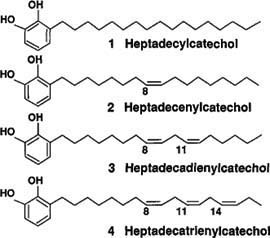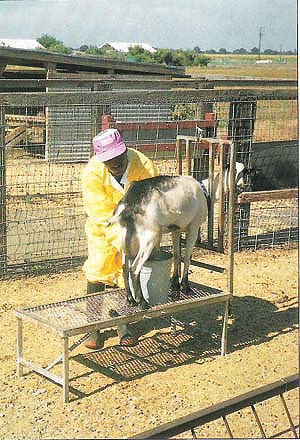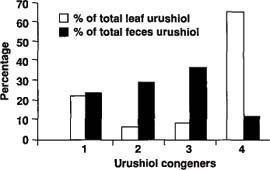All Issues
Initial research indicates dairy goats used to clear poison oak do not transfer toxicant to milk
Publication Information
California Agriculture 46(3):4-6.
Published May 01, 1992
PDF | Citation | Permissions
Abstract
Dairy goats that eat poison oak do not transfer detectible amounts of the toxic principle, urushiol, to the milk or to the urine. Furthermore, this oily, toxic irritant is found in goat manure at less than 9% of its concentration in poison oak leaves. What does all this portend? That farmers using dairy goats to clear poison oak need not worry about contaminating the goats' milk with urushiol. More studies are underway.
Full text
Most Californians are familiar with the painful, often debilitating skin rash (dermatitis) that can result from contact with poison oak. In the United States, three native species of the genus Toxicodendron are often cited for their ability to induce the dermatitis: Pacific poison oak (Toxicodendron diversilobum), mostly found on the Pacific West Coast; poison ivy (T. radicans), found east of the Rocky Mountains; and poison sumac (T. vernix), present in the swamps of the South.
The active principles causing poison oak dermatitis make up a family of oleo-resins, referred to collectively as urushiol. The dermatitis is the result of an allergic reaction, not to urushiol itself but, rather, to the combination of urushiol and the victims’ own skin proteins.
Poison oak urushiols consist of catechol rings with a hydrocarbon side chain at the 3 position. Most poison oak urushiols (98%) have side chains 17 carbons long with one, two or three double bonds (see fig. 1). An oxidized form of the catechol ring does the binding, while the long side arm helps the skin absorb this toxicant. Polyunsaturated side arms are thought to cause a more serious reaction than saturated ones.
Control of poison oak
Eradication of poison oak is the only completely effective method for preventing occupational exposure. Theoretically, digging up the entire plant and burning it is the best method of eradication, but it is prohibitively expensive and exposes workers to extremely hazardous smokeborne urushiol. Biological control appears to be the best way to reduce these poisonous plants, in view of the many barriers to other ways: legal restrictions, environmental hazards, health concerns and/ or the expense of using herbicides, such as glyphosate (Roundup) or triclopyr (Garlon). By itself, 2,4-D does not work very well on poison oak, and 2,4,5-T is no longer legal for this application.
Goats have been used to open up grazing lands for other livestock and also for brush control. Browsing and resulting defoliation of brush by goats lead to subsequent reduction of plant carbohydrate reserves, thereby eventually killing the plants. Goats could be used to inexpensively control poison oak in pasture land and recreation areas. With proper management this can be accomplished with relatively little damage to nontarget plant species and to the environment.
Because the fate of urushiol ingested by goats is unknown, a concern exists for the safety of people using goat dairy products from poison oak-fed goats. This concern, in addition to American folklore crediting milk from poison oak-fed goats with inducing tolerance, led to testing the following hypotheses:
Trial I: poison oak as supplement
Six lactating goats at the UC Davis (UCD) Dairy Goat Facility were fed mature poison oak free choice for 3 days, in addition to their daily feed allotment of 2 kg of corn-alfalfa pellets. The plant material for this trial was collected from the Oak Regeneration Research Plot at the Sierra Foothill Range Field Station, transported to the dairy goat facility and stored under cover until fed to goats. The foliage was weighed, offered as leaves and stems, and the refused feed (predominately stem) weighed the following morning. Total intake was 840 g/d of fresh leaves per feeding for all six does.
The does were milked twice every day and the milk was sampled every other day, frozen at 28°F and sent to the research laboratories of phytochemistry and toxicology at UC Irvine for analysis of urushiol content by High Performance Liquid Chromatography (HPLC) and infrared spectroscopy.
Trial II: poison oak as 100% diet
Four lactating goats from the UCD Dairy Goat Facility were individually housed in elevated calf pens in the calving barn of the Sierra Foothill Range Field Station (SFRFS) for 10 days. Poison oak foliage was collected every morning from the same field as trial I. Goats were individually offered an average of 1.7 kg/d of freshly cut poison oak with no supplementation.
The refusals were weighed each following morning, the pens were cleaned, and the does were milked by hand. Milk yield was recorded at each milking, and the milk was sampled every other day, in addition to the first and last day of the trial. Fresh leaf samples were also collected for analysis of urushiol content, and the leaves oven-dried at 158°F were kept for analysis of nutritive value. Fresh leaves and milk samples were kept frozen at 28°F until analysis. On the trial's seventh day, does were catheterized for urine collection and fitted with fecal collection bags for total fecal collection for 48 hours. Feces and urine were kept frozen until extraction.
Leaves and feces were extracted with acetone (15 ml/g) for 4 days. The crude extract was filtered through Whatman #1 paper. Ten ml of the filtrate were then evaporated to dryness under a nitrogen stream at room temperature. The oily residue was dissolved in 10 ml of methylene chloride and evaporated to dryness. The remaining material was purified with hexane, water and acetonitrile. Milk and urine samples were not pre-extracted with acetone and methylene chloride. The purified solutions were injected through a C18 cartridge column and then filtered before HPLC analysis at UCD.
TABLE 2. Urushiol congeners concentration in leaf (g/g of leaf), feces (g/g of feces) and feces urushiol/leaf urushiol
The eluent, a methanol/water mixture (90:10), was pumped by a Waters 510 HPLC pump through a Pico-Tag C18 reverse-phase column at 1.2 ml/min. The UV detector (Waters 490) was set at 275 nm. The retention times of the chromato-grams were compared with those of the standards of the different urushiol congeners obtained from the UC Irvine laboratories (previously identified by IR and GC/ Mass Spectrometry).
The dry leaves were ground and analyzed for dry matter, ash, nitrogen, ether extract, acid detergent fiber (ADF), neutral detergent fiber, cellulose, lignin, calcium and phosphorus, according to standard procedures used at the UC Davis Animal Science Nutrition Laboratory.
The urine samples were analyzed for catechols by thin layer chromatography (TLC) using KC18F plates and methanol: water (95:5) as solvent and sprayed with 1% FeC13. Heptadecatrienylcatechol obtained from UC Irvine was the standard reference catechol.
Results
No urushiol was found in the milk of trial I goats fed mature poison oak foliage for 3 days as 7% of their diet. For this reason, trial II was planned to challenge lactating does with a stall-fed diet of 100% poison oak foliage.
Table 1 gives the chemical composition of five dry samples of young leaves (first 2 to 3 weeks of seasonal growth) with a small portion of stem (the same portion of plant material consumed by the goats). The crude protein content was between 18 and 22% with a mean of 19.8%. The mean ADF was 13.5% (range 11 to 17%) and is comparable to oats. The leaves were also high in calcium (1.2%) and phosphorus (0.46%), similar to a legume forage.
Feed intakes were very low (mean, SD: 0.645,0.066 kg). The milk yield (mean, SD: 0.810,0.191 kg) observed during poison oak feeding was less than that observed before the trial. Both feed intake and milk yield show a tendency to decrease during the last 10 days of the trial.
Table 2 gives the concentration of each urushiol congener, the total urushiol content in the leaves (3.21 %) and feces (0.28%), and the ratios of feces urushiol to leaf urushiol (8.7%).
Figure 2 shows the percentage of each urushiol congener in the leaf and feces samples. There were more of the partially saturated congeners 2 and 3 in the feces than in the leaves. The fecal concentration of the highly polyunsaturated congener 4 is only 1.5% of that found in the leaves.
Absolutely no peaks were found in milk or urine chromatograms at 9.49, 12.58, 17.74 and 20.09 minutes, where the authentic urushiol congeners 4, 3, 2 and 1, respectively, were present in standards and in poison oak leaf extracts. The lower limit of urushiol detection was 117 ng as determined by calculation. This is equivalent to .218 ng/ml in the milk.
The qualitative TLC monitoring for catechol detection (an index of urushiol breakdown products) in the urine samples gave a negative response. The reference catechol was easily detected at 0.023 mg/uL.
Discussion
In these experiments the goats were fed poison oak foliage, but the urushiol was detected only in the feces. The percentage of total urushiol accounted for by each of the four congeners increased in the feces except for the highly polyunsaturated congener 4. One explanation for the relative paucity of unsaturated urushiol would be biohydration (saturation) of urushiol in the highly reduced rumen or lower-gut environments. Another possible explanation would be greater oxidation and bio-degradation of the more unsaturated urushiols.
Estimated daily total urushiol disappearance was 20.17 g/d, based on a 48-hour fecal collection. This means that more than 90% of the urushiol is either catabolized somewhere along the GI tract, or absorbed. If absorbed, where did all this urushiol go? It could have:
The reduced milk production in the second trial was probably due to reduced feed intake. These same goats accepted more mature poison oak foliage after the pen trials, and three of them had accepted mature leaf as part of a diet containing alfalfa fiber during the previous year. Feed intake problems during this trial may have been a reaction to confinement or the lack of structural carbohydrates in the 100% poison oak diet.
Although rich in energy, protein, calcium and phosphorus, this immature foliage lacked the fiber quality and quantity needed to sustain normal rumen function and feed intake. This diet had no more functional fiber than a diet made up of 100% oat grain. While foliage from later in the season contains more fiber, a source of long roughage should be fed to enhance the utilization of this highly nutritive browse species.
Conclusion
This study is the first phase in a four-step project. The overall objective of the project is to create a complete, low-input biological control system to control poison oak by browsing goats. This study’s specific goal was to determine whether urushiol and/or its metabolites would be found in the milk, urine and feces of dairy goats earing poison oak. From the data collected and the procedures used in our initial studies, no urushiol was identified in the urine or in the milk. Urushiols were found only in the feces.
Based on the finding of this initial research, it is not possible to conclude that potentially immunoactive urushiol metabolites are not found in the milk or the urine, because the procedures used here were specific for catechol analysis. In the next stage of this project, better methods will be developed to trace the fate of urushiol metabolites in meat and milk, and their elimination products, of dairy goats browsing poison oak. The third stage will tell us how much and when to browse poison oak to ensure optimum control. The final stage is the creation and extension of practical, commercially viable production systems including goats as biological control for poison oak.










